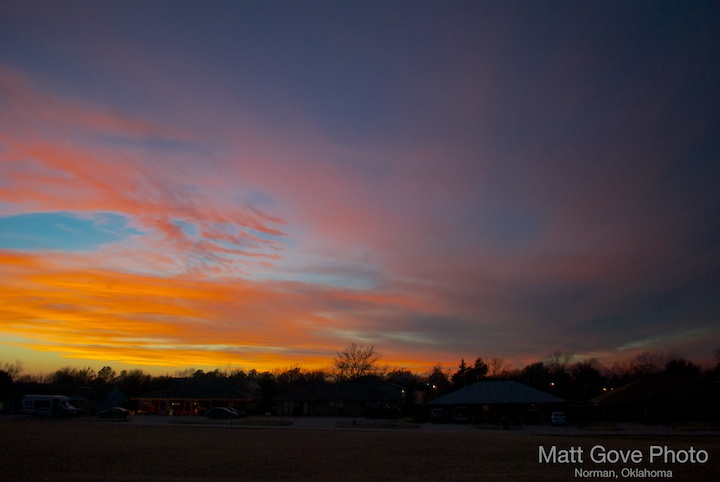Well, we are now into the heart of winter, which also somewhat ironically means that for many locations we are at the best time of year for viewing and photographing sunsets. While many associate sunsets with warm weather, the cooler and drier air during the wintertime actually cuts down on haze and acts to enhance the colors.
Best Meteorological Setup for Good Sunsets
In order to get a good sunset, you need something in the atmosphere to refract the light and bring the colors out. Fortunately for us, water is one of the best refractors of light out there, and on evenings with good sunsets, there is usually plenty of water in the atmosphere in the form of clouds. Lots of thin, mid-to-high-level clouds usually produce the best sunsets. Did you know that the best sunsets often come as the leading edge of an upper-level storm system is moving into your area? For those of you that live in more arid climates, blowing dust and wildfire smoke are excellent refractors of light and can make for just as gorgeous sunsets as those mid-to-high-level clouds. The best case scenario is if you can get some combination of the two because the light gets refracted twice.
DSLR Tips
When you go out to shoot a sunset, the first thing you will want to do is take your camera off of the “Auto” mode. I find you have the most control over the shot if you use the “Shutter” Mode because you can make small adjustments to the shot quickly and on the fly. The exposure should just make the landscape in the foreground silhouetted. If you really nail it, you will just barely be able to pick out individual objects in the foreground, but you won’t be able to tell what color the object is. Shutter speeds will be short, so I usually start with shutter speeds around 1/100 or 1/250 seconds and adjust accordingly. I can’t give you a definite speed to shoot for because the ideal shutter speed varies greatly depending on what time it is in relation to the sunset.
If you’ve ever read any of my weather photography tips, the same concepts apply to framing your sunset photos. The landscape in the foreground should take up at most the bottom third of the photo. Any objects that dominate the foreground such as trees, buildings, cars, boats, or mountains should be kept to the side of the frame and made as small as possible by zooming out. You obviously want a clear view to the west and a meteorological setup for good sunsets. I should also point out that you should avoid having the actual sun in the photo. The sun will wash out any colors you have and wreak havoc on your exposure, and can also damage your camera and your eyes. This issue can be solved by taking your photos with the sun behind a low-level cloud, or shoot just after the sun disappears below the horizon. The left-hand photo below was taken after the sun set, while the photo on the right was taken before the sun set.

Sunset as the leading edge of a winter storm approaches Norman, OK

Winter sunset over the Gulf of Mexico near St. Petersburg, FL
Tips for Smartphone Sunset Photography
Sunset photography using a smartphone or a camera that you can’t control the shutter is suprisingly easy. I have taken some incredible sunset photos using just an iPhone. On a smartphone, the correct exposure for a sunset picture can be obtained simply by tapping on the screen and getting the camera to focus on the sunset. In other words, tap on the sky, not on the foreground landscape and the phone will illuminate the sunset colors and silhouette the foreground. For a point-and-shoot camera or a camera that does not have a touch screen, aim the camera up so there is no foreground in the frame. Push the button half way down to focus on the sunset. With the button still held half way down, move the camera back down to bring the landscape (which should then be silhouetted) into the shot, and then shoot. It’s a crude method at best, but it does work.

Same as top image above, but taken with an iPhone

Late fall sunrise over Norman, OK, taken with an iPhone
Hope you enjoy these tips. Happy sunsetting.